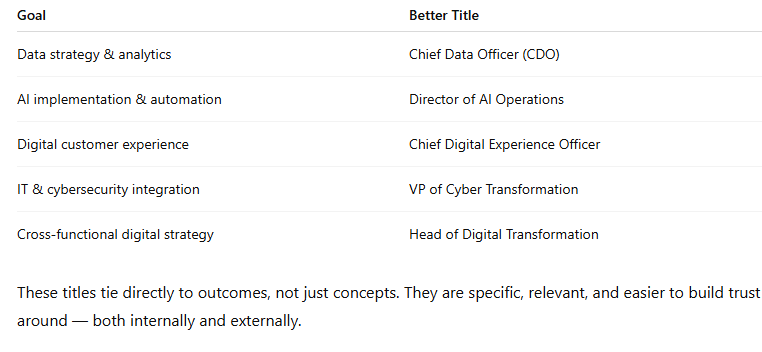In the era of artificial intelligence, hyper-automation, and real-time data ecosystems, companies are in a constant race to demonstrate that they are forward-thinking and technologically savvy. One way they attempt to do this is by creating flashy titles for leadership roles. Enter the “Digital Information Leader” — a title that, despite its seemingly futuristic tone, has become more of a buzzword badge than a meaningful designation.
What was once intended to signal digital maturity and innovation now often feels hollow, vague, and, in many cases, performative. This article explores why the term “Digital Information Leader” has lost its meaning and what organizations should consider when redefining their leadership roles in a digital-first world.
The Ambiguity Problem: What Does the Role Actually Mean?
One of the main reasons the title “Digital Information Leader” falls flat is because it lacks clear definition. Is this role focused on data governance? Cloud strategy? IT systems modernization? Cybersecurity? The title is too broad to offer clarity and too generic to signal specialization.
Compare this to titles like:
- Chief Information Security Officer (CISO) – clearly responsible for enterprise security.
- Chief Data Officer (CDO) – focused on the lifecycle and use of organizational data.
- Chief Digital Officer (CDO) – leading digital transformation initiatives across departments.
“Digital Information Leader” feels like a middle-of-the-road mashup of several distinct roles, lacking the specificity that inspires confidence or authority.
Buzzword Soup: Sounding Important Doesn’t Make It Effective
“Digital.”
“Information.”
“Leader.”
Individually, these are all powerful words. But when strung together without context, they can come off as an empty attempt to sound modern or strategic. In boardrooms and tech teams alike, this title often gets an eyebrow raise rather than admiration — and that’s a problem.
Much like “synergy” or “disruptor,” the phrase has become a buzzword soup. Its overuse has diluted its power, and the lack of measurable accountability attached to it makes it hard to take seriously.
No Authority, No Budget, No Results
In many organizations, the person holding the “Digital Information Leader” title is given a leadership label — but not the leadership authority.
They may not have:
- Budget autonomy
- A team to lead
- Executive sponsorship
- Decision-making power
This creates a mismatch between title and reality. Internally, this leads to confusion about who owns digital initiatives. Externally, it becomes difficult to explain what the person actually does, especially when trying to engage stakeholders, partners, or customers.
If leadership is in the title, it must be in the function too. Otherwise, it sets the leader — and the organization — up for misalignment and failure.
Digital Isn’t a Department — It’s a Culture
Another issue with this title is that it implies digital strategy is siloed to one person or team. In high-performing organizations, digital isn’t confined to a leader — it is embedded across the business.
Modern digital transformation is about cross-functional integration:
- Sales uses automation and CRM intelligence.
- HR adopts AI-powered hiring tools.
- Customer support runs chatbots and sentiment analysis.
A “Digital Information Leader” cannot — and should not — be expected to single-handedly drive digital across departments without proper structure and buy-in.
Titles that reflect this holistic integration—such as “Chief Experience Officer,” “VP of Digital Transformation,” or “AI Integration Lead”—better capture what modern digital leadership actually involves.
Title Inflation Is Real — And Risky
There’s also the reality that companies today inflate job titles to retain or attract talent, especially in tech roles. This isn’t inherently bad, but it backfires when:
- The role doesn't change.
- The compensation doesn’t reflect the title.
- The person lacks the skills or support to deliver on expectations.
Calling someone a “Digital Information Leader” when they’re effectively an IT project manager or a SharePoint admin doesn’t just harm morale — it can create false expectations internally and externally.
Worse, it devalues real digital leadership when it does show up.
No Real Link to Modern Innovation Trends
Perhaps the biggest issue is that “Digital Information Leader” sounds stuck in 2010.
Today’s innovation drivers are:
- Artificial Intelligence and Machine Learning
- Cloud-native security architecture
- Zero Trust implementation
- DevSecOps pipelines
- Intelligent automation
- ESG data tracking
- Responsible AI governance
Yet none of these are inherently conveyed or implied by the title. In contrast, roles like Director of AI Strategy, Head of Intelligent Automation, or VP of Cyber Risk & Innovation signal modern relevance and action-oriented focus.
The “Digital Information Leader” title often feels a step behind — like a relic of early digital transformation efforts rather than a future-facing role.
External Perception: "What Do You Actually Do?"
In an increasingly digital economy, your title should communicate value to your peers, customers, partners, and investors. A title like “Digital Information Leader” does none of that effectively.
When a stakeholder asks, “What does your digital leader do?” and the answer is “They help manage our SharePoint and IT roadmaps,” there’s an obvious mismatch.
Perception is everything in competitive industries. If your leadership structure looks outdated or performative, your partners may question your innovation pipeline.
What Should Replace It? Smarter, Clearer, Mission-Focused Titles
If “Digital Information Leader” is too hollow, what should organizations use instead?
Here are a few role titles that offer more clarity, energy, and alignment with real business priorities:

These titles tie directly to outcomes, not just concepts. They are specific, relevant, and easier to build trust around — both internally and externally.
Leadership Is More Than a Label
If there’s one lesson from the rise and fall of titles like “Digital Information Leader,” it’s this:
Real leadership is measured by impact, not optics.
The digital economy requires leaders who drive measurable change, deliver secure and scalable systems, and transform culture — not just those with futuristic job titles. Organizations must move beyond buzzwords and toward clearly defined roles that reflect both responsibility and results.
So the next time someone proposes appointing a “Digital Information Leader,” ask:
What will they actually lead — and will anyone follow?